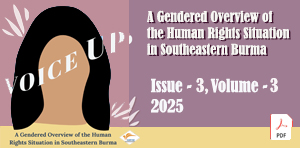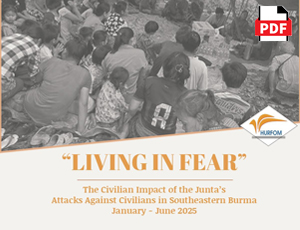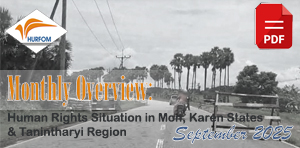Mon and Karen populations worry as census looms
December 17, 2013
HURFOM field reporters visited communities in Mon and Karen States two weeks ago to collect local opinions about the upcoming nationwide population census. Conversations revealed that many residents were either concerned or not informed about the census, and several people declined to comment because they said they were hesitant to discuss a government plan that they did not understand. The government and international donors, led by the United Nations Population Fund (UNFPA), are coordinating the census planned to begin on March 30, 2014.
A member of a Karen armed group in Kyainnseikyi Township described his concerns about the potential for misuse of information collected during the census.
“Their questions cover not only populace, social, and economic information but also land territory data that could be used for military strategy in the future. Those of us from armed groups worry a lot about our security. I believe that [the purpose of a] census is to collect information like how many people there are, where they live, what their sex is, and how many elderly people there are. In addition a census could cover where people are born and how they live, but that’s all I think. However, [the government’s] plan this time is to collect all [kinds of] data.”
Two years ago government order No. 59/2011 established the Central Census Commission and Committee now chaired by Minister U Khin Ye from the Ministry of Immigration and Population and vice-chaired by members of union ministries like the Ministry of Home Affairs and the Ministry of Agriculture and Irrigation. Supervising committee groups have also been organized in states, districts, townships, and villages across the country, and an enormous 100,000-person team of trained enumerators will perform the census taking.
According to one local teacher linked to a government department, “It is said that the government will use teachers and volunteers [to secure] human resources of about 100,000 people nationwide [to implement the census]. The main people they will ask are male and female teachers from primary schools. They will train the teachers to ask [the census’] 41 questions. What I’m worried about is that ethnic people’s populations may [appear] less than before. [The census form filled out by the teachers] has 41 answer boxes for 41 questions that are very complex. There will be a code to put in the boxes instead of words. We need to consider whether the teachers [will be] able to learn all the complicated questions correctly in a short time. We need to think about whether [the teachers] can complete and accurately fill in all the boxes. We, ethnic people, need to carefully monitor whether a person manipulates the answers. For instance, if the question is, “What’s your ethnicity,” the [census takers] are not allowed to write Mon or Karen or Shan in words but in code. So it could be possible that teachers put the wrong code sometimes or do it deliberately. When [later] entering the data into the computer, the responsible people could easily change the code. These are very worrying issues for ethnic people. Ethnic populations are already small and if the data is corrupted, ethnic people will suffer a lot.”
Universal Children’s Day commemorated on Thai-Burma border
November 27, 2013
WCRP: Nearly 1,000 children and community members living near the Thai-Burma border joined events last weekend to commemorate Universal Children’s Day on November 20. Families from Bleh Don Phite and Palain Japan villages in New Mon State Party (NMSP)-administered areas participated in the festivities, with activities also organized in the Karen village of Htee Wa Doe. On the Burma side of the border town of Three Pagodas Pass, over 500 students, teachers, monks, and local residents attended celebrations held at the Dama Hay Won Karen School. Read more
Migrants in Thailand reflect on going home
November 27, 2013
HURFOM: After years carving out lives as migrant workers near the Thailand-Malaysia border, several ethnic Mon people revealed to HURFOM their conflict-ridden memories of Burma and their opinions about finally returning home. Taken together, the 10 interviewees lost 143.5 acres of land to military confiscations in Tenasserim Region’s Yebyu Township that precipitated increased human rights abuses and the residents’ eventual departures. For example, between 2008 and 2011 Navy Department No. 43 seized properties in Ka Dat and Ohn Pin Kwin villages to expand their base and deploy more troops to the area. In discussions many former landowners wondered why, today, battalions still cling to confiscated land on bases that seem too large for contemporary purposes, and expressed that military withdrawal is a prerequisite before considering the long trek home.
Farming families’ properties usually represented their primary source of income, and many who lost their livelihoods along with their land were forced to perform jobs without compensation for troops stationed nearby. Residents also reported paying security taxes levied against them by local battalions for keeping the area safe and usage fees for the right to continue cultivating their own land. Many of the practices of arbitrary taxation, confiscation of working farms and plantations, and forced porter duty came out of a “self-reliance” policy imposed by the government that cut food and salary support for troop outposts.
Former Yebyu resident Nai Khin Htew explained that after his 6.5-acre rubber plantation was confiscated in Kyauk Hta Yan, a small village in the Kywe Thone Nyima village tract, he moved with relatives to Hat Yai in southern Thailand. At the time of confiscation, he said there were 2,300 rubber trees ready for tapping on his land and estimated the plantation to be worth at least 30 million kyat. Following the land seizure he was forced to work for the local battalion and pay monthly security fees to Navy Troop No. 43 in neighboring Ohn Pin Kwin village, leading to his decision to leave for Thailand with his wife and two children.
“It was not a problem to work here [in Thailand] because we were already familiar with this kind of job [on a rubber plantation], although there is a big difference between being a tenant and a landowner. But we do have more security here. In Burma we had to hide what we earned [because military taxes were based on a household’s perceived income]. There are a lot of Mon people here so as long as we are united, we don’t have to worry about our safety. If we have [Thai migrant] passports, we don’t have to hide. But I always think back to my plantation. I cannot describe how I felt upon losing our plantation because we had invested so much time and money into it. Who can help us get our land back one day? It is not easy to solve because [the soldiers and navy] still have power. But we always hope to get [our plantation] back.”
According to Nai Khin Htew, now 40 years old, hundreds of migrant workers live in the Hat Yai District and along the Thailand-Malaysia border after fleeing villages like Gan Taw, Mae Taw, Mae Tan Taung, Ma Yan, Phu Kyi, and Pyaing when their lands were seized by Light Infantry Battalion (LIB) No. 282 and Navy Troops Nos. 43, 273, and 403.
“All my family members are here,” said 48-year-old Nai Mae who works on a rubber plantation in Thailand. “The reason we fled was because we were tortured not only by the Burmese military but also by the Mon splinter groups like Chan Dein, Nai Bin, and Nai Saung. We used to watch people being shot by the military right in front of us. Beatings and lootings became common for us. We were sometimes forced to stand out in the hot sun as punishment. We don’t think it’s a difficult situation for us to work here [in Thailand] compared to what we faced in Burma. Although this is not our country, we get to keep what we earn and don’t have to pay others. In Burma we were the ones who worked but the military and Mon splinter groups were the ones who benefited. We don’t even have our houses [in Burma] anymore. In 2009, the Burmese military burned down all the vacant huts and houses. And as long as the village administrator supports the Burmese military and [keeps] his position of authority, we don’t think we can go back to the village.”
Human rights observers in Burma have noted that in the past few years the government has greatly reduced forced labor, restrictions on mobility, and other previously commonplace abuses. In eastern Burma, some residents described a general sense of calm in rural villages since ceasefires were signed between the President Thein Sein administration and non-state armed groups like the New Mon State Party and Karen National Union. However, reports persist of new land grabs for development projects or the extension of existing military bases, flare-ups with splinter groups, and the failure of military battalions to withdraw from formerly confiscated land. Under these conditions village residents now living in neighboring countries remain unwilling to venture home.
“The main thing we have to consider is whether the military is still located in [our native] areas. If the military is still there, we cannot shake the idea that abuses will continue,” said Nai Wanna, 40, who works in Thailand’s Surat Thani Province. “When I was young, I remember LIB Nos. 282, 273, and 404 [being stationed in the area]. At the time of [my] land confiscation there were eight military battalions in Yebyu Township and navy ships landing nearby. The more military troops there are, the more violations that occur. Transitional reform happens only at the upper levels. As long as the soldiers in those [rural] areas are holding their guns, they still want to treat locals badly. No one can guarantee otherwise. If the military troops are reduced and withdrawn, and our land is given back to us, it would be possible for us to go back.”
In other post-conflict societies, efforts have been made for government representatives, civil society members, aid groups, and community-level leaders to cooperatively implement resettlement and rehabilitation programs for victims of forced displacement or land confiscation. However, local observers commented that these programs would not effectively take root in Burma without government acknowledgement of former military abuses and compensation for villagers’ losses, a move many said they doubt would happen.
“The conflicts in our village are not just because of the military but also Mon armed [splinter] groups that harass us – people with weapons who want to abuse their power,” said Nai Kyaw Lwin, a former resident of Cha Pone village who lost four acres of betel nut and durian trees to military confiscation. “If those people were not in the village, we could go back safely. If our villages were peaceful to live in, we would be happy to do any kind of job [there]. Since Thailand is not our native country, it’s impossible for us to live here forever. Our children’s education is precarious here [because they lack Thai identification cards]. Nothing has changed, and we have not made any decisions yet. We will go back when there are no armed groups and no military. My [confiscated] plantation could have been passed to new owners two times over [by now], so although we still hope to get it back I don’t think we will.”
WCRP releases “Children for Hire” to mark Universal Children’s Day
November 20, 2013
The Woman and Child Rights Project (WCRP) has released its report, “Children for Hire: A portrait of child labor in Mon areas,” to illustrate the incidence of child labor in rural Mon communities and along Burma’s eastern border. Drawn from 67 interviews conducted with working children and their families, health workers, public sector and civil society members, and child protection officers, the report aims to elevate the voices of underage workers and expose the less visible forms of child labor that exist outside of urban settings. Download full report HERE. Read more
Tavoy farmers encounter harsh response to compensation appeals
November 14, 2013
HURFOM: Two decades after government authorities confiscated more than 300 acres of farmland in Tavoy, the capital of Tenasserim Region in southern Burma, farmers report that they are seeking restitution at long last. Former landowners said their hopes were particularly buoyed by a speech given by Thura U Shwe Mann at the Tavoy City Hall in September. According to attendants, the speaker of the lower house of the Burmese parliament, or Pyithu Hluttaw, said that since most farmers’ lands were passed down through ancestry or customary rights, many would have been unable to produce the official land documents requested at the time of confiscation to ward off property seizure. He reportedly urged traditional land ownership practices to be acknowledged and considered during the land appeals process.
“Broken promises” at Pyar Taung cement project
November 7, 2013
HURFOM: Thailand’s largest industrial conglomerate, Siam Cement Group (SCG), is reportedly collaborating with Pacific Link Cement Industries Ltd. to construct a 12.4 billion baht cement plant in Kyaikmayaw Township, southeast of the Mon State capital. But residents of Pyar Taung village, located on the eastern bank of the Attaran River that bisects Kyaikmayaw, have alleged that the fledgling project has been accompanied by rampant unjust land acquisition and numerous “broken promises” made to villagers by the companies. Read more
Beer, brothels, and bribery in Myaintayar quarter
November 4, 2013
HURFOM: Almost three decades ago the capital city of Moulmein in Mon State was divided into quarters, with one, Myaintayar, designated as a residential area solely for civil servants and military families. But over the years, political promotions moved government employees to other parts of the country and Cyclone Nargis brought a swell of internal migration to the city, resulting in a more diverse population that expanded neighborhoods and filled vacated homes. Today, Myaintayar quarter is a mix of urbanite shopkeepers and hotel owners, laborers working in Mon State’s large industrial and agricultural sectors, NGO personnel and office representatives of various armed ethnic groups, and a sizable community of students and staff from nearby Mawlamyine University. Read more
Motorbike drivers arbitrarily taxed in Kyaikmayaw Township
October 29, 2013
HURFOM: The highway that connects Mudon and Kyaikmayaw townships is a busy corridor for area residents. Manual laborers travel the passage daily to work the many adjacent rubber plantations, moto-taxi drivers pick up fares in nearby villages, and merchants buy goods in Moulmein, the capital of Mon State, to bring back and sell to local communities. But residents reported that since earlier this year, an illicit tollgate has been set up on the road and manned by individuals from a number of local groups, including police and militia members, who unfairly target and tax motorbike drivers. Read more
Rise in bars and brothels in Ohn Pin Kwin
October 25, 2013
WCRP:The large village of Ohn Pin Kwin in southern Burma lies along a gas pipeline that is longer, but less well known, than the controversial Yadana pipeline it connects to. During its construction over 2,400 acres of land were seized between Kanbauk in Tenasserim Region and Myaing Kalay in Karen State, and for which villagers received little to no compensation. Read more
“Tuition” practices continue in Mon State
October 22, 2013
WCRP: Despite regulations placed on schoolteachers by the education department in Moulmein, the capital of Mon State, the fee-based, after-school tutoring sessions known as “tuition” allegedly continue to be offered to students. A common characteristic of the Burmese education system, tuition increases schooling’s cost burden on families and puts pressure on students who say their grades and exam scores would suffer without the extra instruction. Read more



















































